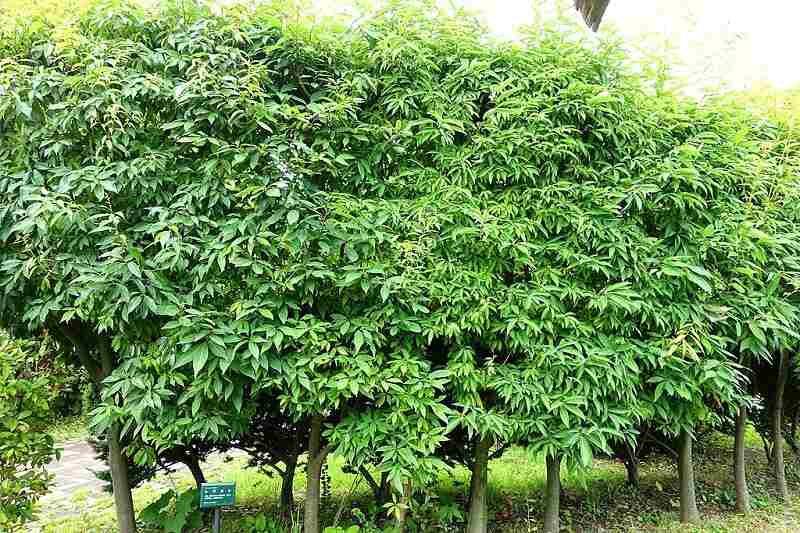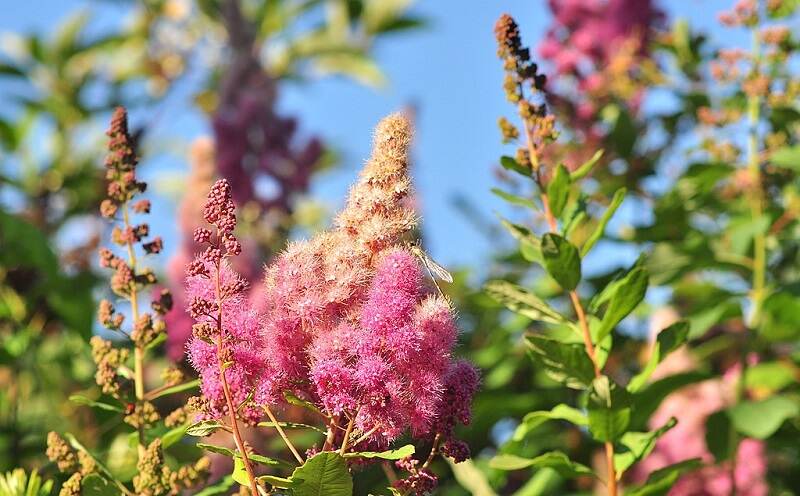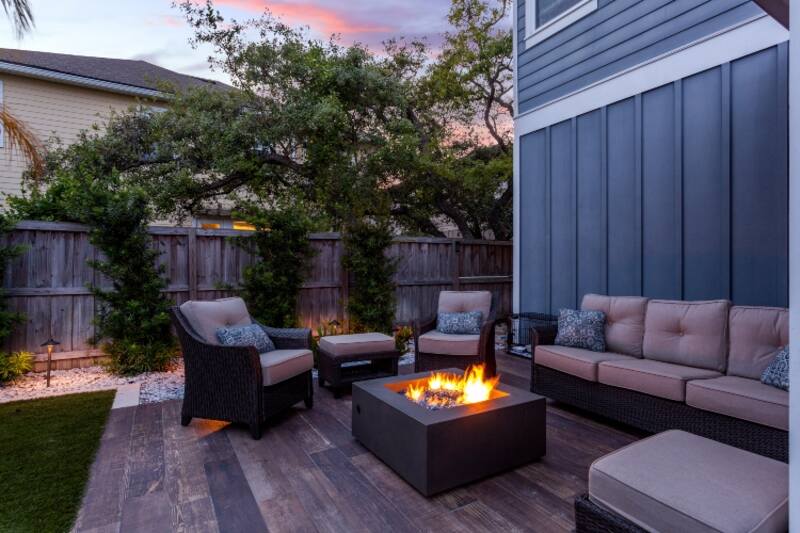
In a place known as the City of Roses, beauty standards for your landscape are pretty high, but that doesn’t mean you have to spend all your free time on yard work. You can have a gorgeous landscape with little effort, and we can help. Give these 12 low-maintenance landscaping ideas for Portland yards a try to achieve the yard of your dreams the easy way.
12 Ways to Create a Low-Maintenance Portland Yard
1. Perennial Dreams

For a garden that’s full of colorful blooms year after year without having to add new plants every spring, use perennials. Unlike annuals, perennials come back on their own after their dormant season. Perennial plants last for at least three years, and in some cases, many years beyond that.
Portland’s signature roses are a good example of perennials that grow well in this climate, which makes them one of the best outdoor plants for Portland, Oregon. Once you plant a rose bush, such as the knockout rose pictured above, roses will adorn your landscape for years to come.
Which roses are best for your yard? The Portland Rose Society has compiled a list of rose species recommended for gardens in this area. There are plenty that would make a beautiful addition to your outdoor plants:
- Amber Queen
- Artistry
- Starry Night
- Crimson Bouquet
- Autumn Splendor
There are many low-maintenance perennials that thrive in Portland’s growing zone besides roses, too, including:
- Catmint
- Hellebore
- Yarrow.
2. Give Evergreens the Green Light

Evergreens are another low-maintenance option for your garden and plant beds. Since evergreens retain their leaves all year, they won’t have you wasting your autumn weekends raking up their fallen leaves.
There are many different shapes and sizes of evergreen shrubs, trees, ground covers, and vines. They aren’t all conifers and pine trees, either. Some more exotic and interesting evergreens, including the bamboo leaf oak pictured above, are hardy enough for Portland.
3. Never Enough Natives

Whether you’re talking perennials, evergreens, or another class of plants, native Portland plants are your best bet for the most low-maintenance landscape possible in the Pacific Northwest.
Here’s why: Native plants grow naturally in the local climate, so they’ve adapted to the cold snaps, heat waves, dry spells, and long stretches of rainy days. That means they won’t die on you easily.
Since native plants know how to grow in the area on their own, they won’t need much maintenance like fertilizing, watering, or pest control from you. They also can survive Portland winters without frost protection measures (in most cases).
Portland’s beautiful natives that would look great in your landscape include:
- Oregon iris
- Pacific crabapple
- Douglas spiraea (pictured above)
4. Got Mulch?

Adding some mulch to your garden and flower beds can make them more low-maintenance. Mulch smothers weeds before they have a chance to grow, so it will eliminate weeding from your landscape to-do list.
Added bonus: Mulch also can help plants retain moisture, so you won’t have to water your plants as frequently during dry periods.
If you choose an organic mulch such as wood chips or bark, keep in mind that you’ll have to replace it every spring after it breaks down into the soil. Inorganic mulches like rubber or stones take less work because one layer can last for years.
Mulch alone might not be enough to prevent weeds completely in some gardens. In those cases, you’ll want to install landscape fabric or another weed barrier under your mulch to finish the job.
If you’d rather not deal with landscape fabric, try a landscape fabric alternative, such as cardboard, newspaper, or burlap. Weed fabric alternatives are often biodegradable and cheaper than traditional landscape fabric, yet they serve the same purpose.
5. Garden for a Rainy Day

Photo Credit: EmilyBlueGreen / Wikimedia Commons / CC BY-SA 3.0
With a rain garden, you won’t have to worry about watering your plants, and you won’t have to worry about your property flooding from excessive rain. That’s because rain gardens collect stormwater runoff. Nature will water this garden for you.
In addition to being good for you and your landscape, rain gardens are good for the environment, too. Plants’ roots filter pollutants out of rainwater before it flows naturally back into the Willamette River and other bodies of water. Your future rain garden could help Portland remain one of the “green”-est (most eco-friendly) cities in the country.
When designing your rain garden, you will want to look for plants that can tolerate both drought and flooding. Your garden should be able to withstand dry spells and sit in standing water for up to 48 hours after rainfall.
6. Xeriscape ’Til you Ache

Xeriscaping is another water-wise alternative to a traditional garden, but this one works much differently than a rain garden. Instead of getting water from nature, a xeriscaped garden simply doesn’t need much water at all.
Xeriscapes feature drought-tolerant (native) plants and hardscapes, so they can go a long time without water. You won’t have to worry about watering a xeriscape, even during dry spells. That means it will save you money on your water bill compared to a standard landscape.
For the most successful xeriscape, use succulents (that’s right, you can grow succulents, outdoors in Portland) and drought-tolerant native plants:
- Creek dogwood
- Hairy manzanita
- Oregon grape
- Stonecrop
7. Ditch the Bed, Plant a Container Garden Instead

Instead of putting your plants in a landscape bed in the ground, consider creating a container garden featuring the best outdoor potted plants for Portland, Oregon that will be much easier to care for. Try a combination of annuals to have “thrillers” as focal points, and “fillers” to bring it all together:
- Cordyline (thriller)
- Purple fountain grass (thriller)
- Coleus (filler)
- Dusty Miller (filler)
- Snapdragons (filler)
With a container garden, you won’t have to get down on your knees to tend your plants. That can be a major bonus for people with limited mobility.
Container gardens also will require less work when winter (or random cold snaps in spring and fall) rolls around. You won’t have to cover your plants or take other frost protection measures for your garden, since you can just bring the pots inside when temperatures start to drop.
Bringing plants inside for winter allows you to use more tropical specimens in your garden because they won’t have to survive freezing or near-freezing temperatures.
8. Get Ready to Rock (Garden)

A rock garden is the most low-maintenance garden you could ask for because it doesn’t have to include plants at all. In a rock garden, the main focus is stones, boulders, and gravel. You can add a few plants or a water feature if you want, but that’s up to you.
You can design your rock garden in any style you want, just as you would with a regular garden, but you won’t have to worry about keeping this one alive.
9. A Happy Home for Hardscapes

In place of a garden (either traditional or one of the lower maintenance options we’ve covered), you could fill your front and backyard with hardscapes.
What is a hardscape? Hardscapes are the nonliving elements in your lawn, such as patios, fire pits, retaining walls, and pathways. Hardscapes only require occasional cleaning, and they take up space where there would otherwise be grass to mow and plants to water.
Interested in putting in a patio? Check out these prices to see what fits your budget:
- A typical patio professionally installed costs between $2,363 and $5,909.
- A paver patio costs anywhere from $3,476 to $8,872.
- A concrete patio ranges from $1,533 to $4,740.
When you install hardscapes with pavers or flagstone, lay a solid foundation first. While it will be more work in the present, this foundation will save you time and energy in the future because it will keep the stones from sliding and shifting over the years.
For more information: Oregon State University’s 10-step guide to installing pavers includes detailed instructions on laying the base material.
Curious about how to spruce up your yard with other hardscaping elements? Give these a try:
- Adding a gazebo to your yard typically ranges from $5,364 to $9,027.
- Or try a pergola for an average cost of $2,216 to $8,959.
- If big projects aren’t your thing, try a fire pit, which ranges from $500 to $3,433.
10. Ground Yourself with Ground Cover

Replacing your grass with a ground cover plant will give you a lush, beautiful lawn without all the maintenance. There will be no more lawn mowing, aerating, or other draining lawn chores for you.
If you want a more traditional lawn, there are many plain green ground covers. On the other hand, you could shoot for a show-stopping lawn with a colorful, flowering variety. Some of the best ground covers for Portland’s USDA Hardiness Zones (8-9) are:
- Creeping juniper
- Ice plant
- Sweet alyssum (pictured above)
11. The Artificial Alternative

While a ground cover lawn would still require some plant care, artificial grass is a completely maintenance-free option. You can’t kill artificial grass (no matter how inattentive you are), and neither can any pets or children who constantly run through your yard.
Artificial grass can be expensive to install, and it doesn’t do any favors for the environment, but if you’re looking for a kid-proof, pet-proof lawn that never needs watering or mowing, you’ve found it.
12. Bring Your Yard Into the Era of Automation

An automatic irrigation system can help your landscape through dry spells without you having to get out in the yard with a watering can every day. Simply set the timer so your sprinklers know when to come on, and they’ll handle the rest. If you want a traditional lawn and garden but don’t want to tie yourself to a watering schedule, an automatic irrigation system might be for you.
The convenience of an automatic irrigation system comes at a cost, though. Installing sprinklers can get expensive, especially since they’ll send your water bill through the roof. The average price of a sprinkler system ranges from $2,539 to $4,773. The good news is they’ll pay you back in their own way by increasing your home’s property value.
FAQ About Low-Maintenance Landscaping in Portland
When Should I Plant in Portland, Oregon?
Fall is the best time to plant, but really you can plant at any time of year. Portland doesn’t typically get too hot or too cold for planting. The only thing you will want to avoid is planting when the ground is frozen. Some plants might thrive when planted in the fall, while others prefer spring. Check your monthly garden calendar for the perfect times to plant throughout the year.
What Low-Maintenance Plants Grow Well in Portland, Oregon?
Portland has many low-maintenance native plants that you can add to your landscape design, including:
- Blue-eyed grass
- Broad-leaf shooting star
- Cusick’s checkermallow
- Baldhip rose
- Black gooseberry
- Evergreen huckleberry
- Vine maple
- Black hawthorn
- Oval-leaved viburnum
- Oregon ash
What is the Cheapest Landscaping for Portland, Oregon?
Many low-maintenance landscaping techniques are also low-cost because they are easy DIY projects, use less water, and won’t require replacing plants frequently. Try out some of these options for cheap landscaping in Portland:
- Mulch is a great way to spruce up your landscaping. Costs range from $17 to $68 per cubic yard. There are also ways to get free mulch in your area.
- Add native plants to bring color to your yard and keep money in your pocket.
- Landscape lighting is a great way to add to the aesthetic of your yard without breaking the bank. Prices will vary depending on the size of your project. Average rates are around $188 to $325 (cost of the lights plus labor). Or hang a few outdoor string lights yourself for an inexpensive weekend DIY project.
When to Call a Landscaping Professional
If you need help designing and installing your low-maintenance landscape, call a local Portland professional landscaper to receive the expert advice you’re seeking. Local pros will know the best plants for your area, and they will have the construction experience required for large projects like installing patios and building retaining walls.
Even beyond design and installation, landscaping professionals can make your life easier. Many contractors offer regular maintenance services such as bush trimming, lawn treatments, and leaf removal.
Along with our low-maintenance landscaping suggestions, these pros can help homeowners have a beautiful Portland yard without the hassle of taking care of it yourself.
Main Image Credit: Ian Poellet / Wikimedia Commons / CC BY-SA 3.0